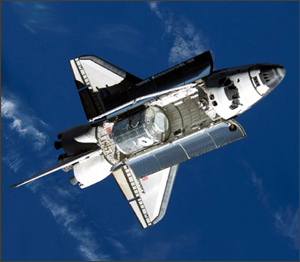
Celestis has conducted the overwhelming majority of memorial spaceflights — and is the only private company to have done so. Here’s a list of launch vehicles that have been used to carry cremated remains into space:
Space Shuttle — A portion of Star Trek creator Gene Roddenberry’s cremated remains flew on NASA’s space shuttle Columbia (STS-52) in 1992 and were returned to Earth.
Pegasus — In April 1997, 24 cremated remains samples were launched into Earth orbit on an air-launched Pegasus rocket on board Celestis’ first memorial spaceflight, the “Founders Flight.” The Celestis memorial satellite orbited Earth until it re-entered the atmosphere in May 2002 northeast of Australia. Gene Roddenberry was on board this mission, and will — along with his wife, Majel — fly into deep space on board a Celestis Voyager Service mission.
Athena II — Celestis provided its first Luna Service mission by helping friends of noted planetary geologist Dr. Eugene Shoemaker include a symbolic portion of Dr. Shoemaker’s cremated remains on the NASA Lunar Prospector mission launched January 6, 1998 from Cape Canaveral Air Force Station, Florida. Launch occurred on a three-stage Athena II rocket. On July 31, 1999 the spacecraft impacted the lunar surface inside a permanently shadowed crater near the south lunar pole, creating a permanent monument to Dr. Shoemaker.

Taurus — On February 10, 1998 30 cremated remains samples flew as a secondary payload launched into Earth orbit on a Taurus rocket. This mission — Celestis’ “Ad Astra Flight” — is still on orbit and has an estimated orbital lifetime of 240 years. The memorial satellite, along with Celestis’ 1999 “Millennial Flight,” can be tracked online.
SpaceShipOne — On September 29, 2004 SpaceShipOne carried the cremated remains of the mother of SpaceShipOne’s designer, Burt Rutan, on a suborbital flight that successfully flew in space and returned to Earth. Virgin Galactic’s SpaceShipTwo is designed, in part, on the basis of SpaceShipOne.
Atlas V — A sample of the cremated remains of astronomer Clyde Tombaugh were part of NASA’s New Horizons spacecraft launched January 19, 2006 by an Atlas V rocket. This NASA mission will fly the discoverer of Pluto past that distant dwarf planet later this year.

SpaceLoft XL — The first Celestis Earth Rise Service memorial spaceflight flew on April 28, 2007. The Earth Rise Service flies the cremated remains into space and returns them to Earth. After the mission each family receives the flown flight capsule, still containing the cremated remains. These annual missions occur from Spaceport America, New Mexico on an UP Aerospace SpaceLoft XL launch vehicle. The cremated remains samples of over 200 people were on board 2007’s “Legacy Flight,” including Mercury 7 astronaut L. Gordon Cooper and Star Trek actor James Doohan (“Scotty”). Both Cooper and Doohan later flew on Celestis’ Earth Orbit mission, the “New Frontier Flight,” and will fly on a future Voyager Service mission.
Delta IV Heavy — On December 5, 2014 NASA launched a cremated remains sample on the Orion Exploration Flight Test-1 on a Delta IV Heavy (ULA) from Cape Canaveral Air Force Station, Florida. The person honored by this special arrangement was a Lockheed Martin aeronautical engineer who worked on the Orion project for over a decade.
